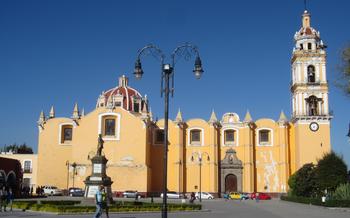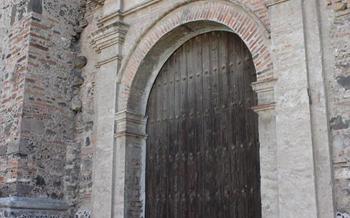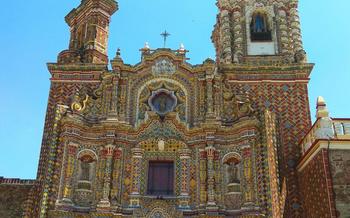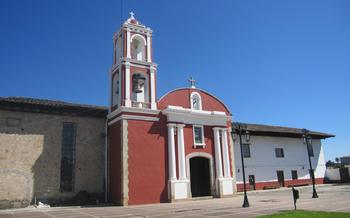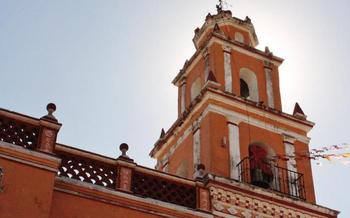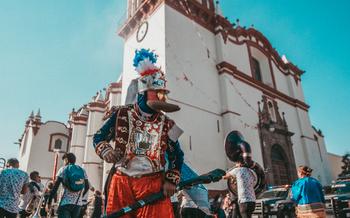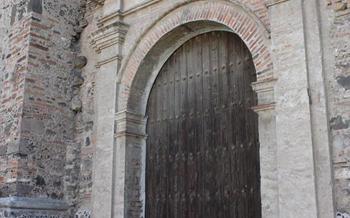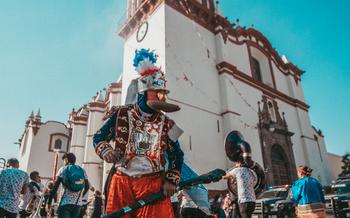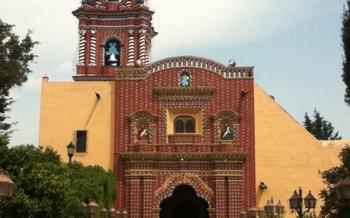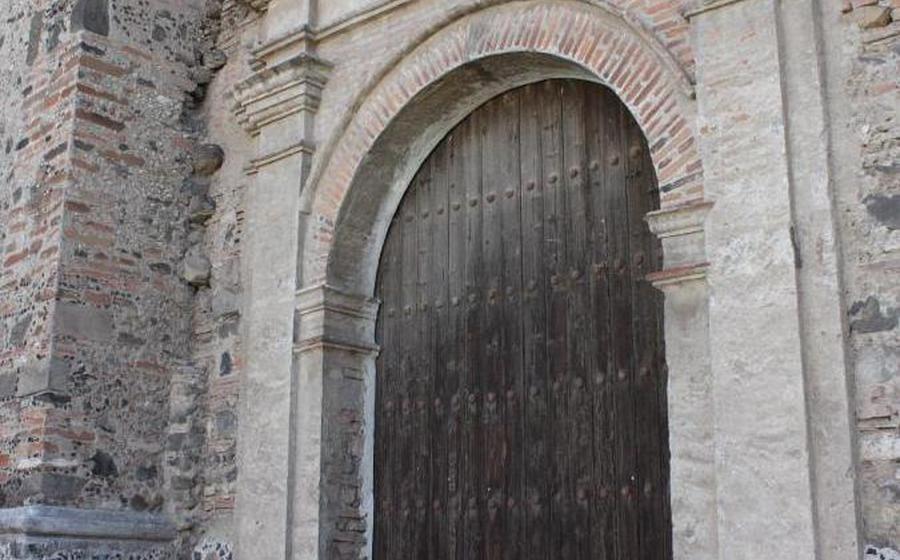
Callejón de los Muertos
- Callejón de los Muertos (Alley of the Dead)
- Museo de la Muerte (Museum of Death)
- La Casa de los Muñecos (House of the Dolls)
- Templo de San Francisco Acatepec
- Museo de Arte Religioso (Museum of Religious Art)
- Mercado Municipal de Cholula (Cholula Municipal Market)
- Zona Arqueológica de Cholula (Cholula Archaeological Zone)
- Museo Regional de Cholula (Cholula Regional Museum)
- Santuario de Nuestra Señora de los Remedios (Sanctuary of Our Lady of Remedies)
- Parque Juárez (Juárez Park)
- Paseo de la Reforma (Reforma Avenue)
- Zoológico de Cholula (Cholula Zoo)
- Jardín Botánico de Cholula (Cholula Botanical Garden)
- Puebla (City of Puebla)
- Insider Tips:
Callejón de los Muertos (Alley of the Dead)
The Callejón de los Muertos (Alley of the Dead) is one of the most famous streets in Cholula, Mexico. It is known for its colorful buildings, elaborate murals, and unique shops. The street is named after the many traditional Mexican altars that are set up here during the Day of the Dead celebrations.
The Callejón de los Muertos was built in the 16th century by the Spanish conquistadors. The street was originally used as a market, and it was lined with shops and stalls selling a variety of goods. Over the years, the street has evolved into a popular tourist destination, and it is now home to a variety of shops, restaurants, and art galleries.
The houses on the Callejón de los Muertos are decorated with a variety of colorful murals, which depict scenes from Mexican history and culture. The murals were painted by local artists, and they are a testament to the creativity and artistry of the people of Cholula.
The Callejón de los Muertos is a must-see for any visitor to Cholula. It is a vibrant and colorful street that offers a glimpse into the history and culture of this fascinating city.
Museo de la Muerte (Museum of Death)
The Museo de la Muerte (Museum of Death) is a unique and fascinating place that explores the concept of death and the afterlife from a variety of perspectives. The museum's collection includes skulls and bones, as well as interactive displays that allow visitors to learn about the history of death and mourning rituals around the world.
One of the most popular exhibits at the Museo de la Muerte is the "Hall of Skulls," which features a collection of over 500 skulls from around the world. Each skull has a unique story to tell, and visitors can learn about the different cultures and beliefs associated with death.
The museum also has a number of exhibits that focus on the history of death and mourning rituals. These exhibits cover a wide range of topics, from the ancient Egyptian Book of the Dead to the modern-day funeral industry.
The Museo de la Muerte is a thought-provoking and educational experience that is sure to leave visitors with a new perspective on death and the afterlife. Guided tours are available in English and Spanish, and the museum also offers a variety of educational programs for students and adults.
La Casa de los Muñecos (House of the Dolls)
La Casa de los Muñecos is a unique museum in Cholula, Mexico, that houses a collection of over 5,000 dolls from around the world. The museum is located in a beautiful 18th-century mansion that once belonged to a wealthy family. The house is filled with dolls of all shapes and sizes, from tiny porcelain figurines to life-sized mannequins.
The museum's collection includes dolls from every corner of the globe, representing a wide range of cultures and traditions. There are traditional Mexican dolls, European porcelain dolls, Japanese kokeshi dolls, and even African voodoo dolls. The museum also has a collection of antique dolls, some of which date back to the 17th century.
In addition to the dolls, the museum also has a number of exhibits on the history of dolls. These exhibits explore the role of dolls in different cultures, as well as the different materials and techniques that have been used to make dolls over the centuries.
The museum's gift shop sells a variety of dolls, as well as other souvenirs related to dolls. Visitors can also purchase tickets for guided tours of the museum, which are available in English and Spanish.
Templo de San Francisco Acatepec
The Templo de San Francisco Acate a pre-Hispanic temple dedicated to the god Quetzalcoatl. The church is constructed in the Gothic-Renaissance style, with a nave and two aisles. The interior of the church is decorated with frescoes and sculptures, and the main altarpiece is a masterpiece of the Mexican Baroque style. The church is a popular tourist destination, and it is also a UNESCO World Heritage Site.
History of the Church
The Templo de San Francisco Acatepec was built between 1540 and 1560 by the Franciscan friars. The church was built on the site of a pre-Hispanic temple dedicated to the god Quetzalcoatl. The Franciscans chose to build their church on this site in order to convert the indigenous people to Christianity. The church was consecrated in 1560, and it became one of the most important churches in the city of Cholula.
Architectural Style
The Templo de San Francisco Acatepec is constructed in the Gothic-Renaissance style. The church has a nave and two aisles, and it is topped by a barrel vault. The exterior of the church is decorated with buttresses and pinnacles, and the interior is decorated with frescoes and sculptures.
Interior Decorations
The interior of the Templo de San Francisco Acatepec is decorated with a variety of frescoes and sculptures. The frescoes depict scenes from the life of Jesus Christ and the Virgin Mary. The sculptures include a number of saints and angels. The main altarpiece is a masterpiece of the Mexican Baroque style. The altarpiece is made of wood and gold leaf, and it is decorated with a number of sculptures and paintings.
Guided Tours
Guided tours of the Templo de San Francisco Acatepec are available. The tours are led by knowledgeable guides who can provide information about the history, architecture, and interior decorations of the church. The tours are available in Spanish and English.
Museo de Arte Religioso (Museum of Religious Art)
The Museo de Arte Religioso is a must-see for anyone interested in the history of the Catholic Church in Mexico. The museum houses a vast collection of religious art from the colonial period, including paintings, sculptures, and textiles. The exhibits trace the development of Catholic art in Mexico from the early colonial period to the present day.
The museum is housed in a former convent, which has been beautifully restored. The interior of the museum is decorated with intricate frescoes and carvings, which create a sense of awe and wonder. The exhibits are well-organized and informative, and they provide a fascinating glimpse into the history of the Catholic Church in Mexico.
In addition to the permanent exhibits, the museum also hosts temporary exhibitions on a variety of topics related to religious art. The museum also offers a variety of educational programs, including lectures, workshops, and guided tours.
Guided tours Guided tours of the museum are available in English and Spanish. Tours last about an hour and provide an in-depth look at the museum's collection. Tours can be booked in advance or on the day of your visit.
Workshops The museum also offers a variety of workshops on religious art. Workshops are typically held on weekends and are open to people of all ages. Workshops cover a variety of topics, such as painting, sculpture, and textile art.
Mercado Municipal de Cholula (Cholula Municipal Market)
The bustling Mercado Municipal de Cholula, or Cholula Municipal Market, is a vibrant hub of local commerce and culture. Situated in the heart of the city, this bustling marketplace has been a gathering place for locals and visitors alike for centuries.
The market is a treasure trove of local produce, handicrafts, and culinary delights. Vendors display their wares in colorful stalls, offering a dazzling array of fresh fruits, vegetables, herbs, spices, and flowers. Artisans showcase their handmade crafts, from intricate pottery and textiles to traditional toys and jewelry.
Foodies will be in paradise as they explore the market's many food stalls and restaurants. Sample traditional Mexican dishes such as tacos, tamales, and enchiladas, or indulge in fresh seafood, grilled meats, and sweet treats. The market also hosts regular cultural events, such as cooking demonstrations, live music, and dance performances.
For a truly immersive experience, join a guided tour of the market. Local guides will lead you through the labyrinthine alleys, introducing you to the vendors and their products. They will share stories about the history and traditions of the market, and help you find the best deals on souvenirs and local delicacies.
Zona Arqueológica de Cholula (Cholula Archaeological Zone)
The pre-Hispanic city of Cholula was one of the largest and most important in Mesoamerica. Its main attraction is the Great Pyramid of Cholula, also known as Tlachihualtepetl, which is the largest pyramid in the world by volume. The pyramid was built over several centuries, starting in the 3rd century BC, and was dedicated to the god Quetzalcoatl. It is estimated that the pyramid was originally over 60 meters high and had a base of over 450 meters on each side.
In addition to the Great Pyramid, the archaeological zone includes several other important structures, such as the Temple of the Painted Skulls, the Temple of the Feathered Serpents, and the Temple of the Altars. These temples were used for religious ceremonies and rituals, and they are decorated with elaborate carvings and paintings.
The archaeological zone is a UNESCO World Heritage Site and is one of the most popular tourist attractions in Cholula. Visitors can explore the ruins of the ancient city, climb to the top of the Great Pyramid, and learn about the history and culture of the pre-Hispanic people of Cholula. Guided tours are available in English and Spanish.
Museo Regional de Cholula (Cholula Regional Museum)
The Museo Regional de Cholula (Cholula Regional Museum) is a must-visit for anyone interested in the history and culture of this ancient city.
The museum houses a collection of artifacts from the pre-Hispanic period, including pottery, tools, and weapons. There are also exhibits on the history of the city, from its founding by the Olmecs to its conquest by the Spanish.
The museum is located in the heart of Cholula, just a few blocks from the Great Pyramid.
Guided tours are available in Spanish and English, and there are also workshops for children and adults. The museum is open from Monday to Sunday, from 10 am to 5 pm, and admission is free.
One of the most interesting exhibits in the museum is a replica of the Great Pyramid of Cholula.
The replica is made of clay and is about 10 meters tall. It gives visitors a good idea of the size and scale of the original pyramid, which was built over 2,000 years ago.
Another highlight of the museum is the collection of pre-Hispanic skulls.
The skulls were found in excavations at the Great Pyramid and other archaeological sites in Cholula. They provide valuable insights into the physical characteristics and burial practices of the ancient inhabitants of the city.
Santuario de Nuestra Señora de los Remedios (Sanctuary of Our Lady of Remedies)
The Santuario de Nuestra Señora de los Remedios, situated Cholula.
The sanctuary's architectural style blends Renaissance and Gothic elements, reflecting the artistic influences of the colonial period. Its interior is adorned with intricate carvings, colorful murals, and gilded altars, creating a sense of grandeur and devotion.
Visitors can climb the 456 steps leading to the sanctuary to enjoy breathtaking views of the surrounding valley and the majestic Popocatépetl volcano. Guided tours are available, providing insights into the history, architecture, and religious significance of this iconic landmark.
The Santuario de Nuestra Señora de los Remedios is not only a spiritual sanctuary but also a symbol of Cholula's rich cultural heritage. It attracts pilgrims and tourists alike, who come to pay homage to the Virgin Mary and marvel at the architectural and artistic treasures housed within its walls.
Parque Juárez (Juárez Park)
Juárez Park is a green oasis in the heart of Cholula, offering a tranquil escape from the bustling city streets. Established in the 19th century, the park is named after Benito Juárez, a prominent figure in Mexican history who served as president during the Reform War. It encompasses a playground for children, making it a popular spot for families.
Visitors can stroll along the park's well-manicured paths, admiring the lush vegetation and colorful flowers. The park also hosts various cultural events throughout the year, including concerts, art exhibitions, and traditional Mexican festivals. Guided tours are available for those who wish to learn more about the park's history and significance.
Paseo de la Reforma (Reforma Avenue)
Paseo de la Reforma that encapsulates the city's colonial past and modern-day charm. Strolling along its cobblestone streets, visitors are greeted by an array of architectural wonders, from the intricate facades of colonial-era mansions to the contemporary glass and steel structures.
At the heart of Paseo de la Reforma lies the ** zócalo, the city's main square. Here, visitors can admire the grandeur of the ** Parroquia de San Pedro Apóstol, a 17th-century church renowned for its ornate Baroque architecture. Across the square stands the ** Palacio Municipal, the city hall, which boasts a striking neoclassical facade and houses the ** Museo de la Ciudad de Cholula, a museum dedicated to the city's history and culture.
Beyond the zócalo, Paseo de la Reforma continues its journey, lined with an array of shops, boutiques, and restaurants. From traditional Mexican cuisine to international fare, there's something to satisfy every palate. Art enthusiasts will delight in the numerous galleries showcasing the works of local and international artists, while history buffs can delve into the city's past at the ** Museo Regional de Cholula**, which houses a collection of artifacts from the pre-Hispanic period to the present day.
As the day draws to a close, Paseo de la Reforma transforms into a vibrant hub of activity. Street performers entertain the crowds with music, dance, and acrobatics, while locals and visitors alike gather at the many bars and cafés to socialize and soak up the lively atmosphere.
Whether you're seeking historical treasures, culinary delights, or simply a leisurely stroll, Paseo de la Reforma offers an unforgettable experience that encapsulates the essence of Cholula's rich heritage and vibrant spirit.
Zoológico de Cholula (Cholula Zoo)
The Cholula Zoo is a must-see for animal lovers and families visiting the city. Founded in 1994, the zoo is home to over 300 animals from around the world, including lions, tigers, bears, monkeys, reptiles, and birds. The zoo is dedicated to conservation and education, and offers a variety of interactive exhibits and educational programs.
Visitors can learn about the natural history and behavior of the animals, as well as the importance of protecting endangered species. The zoo also offers guided tours, which provide an in-depth look at the animals and their habitats.
In addition to the animals, the zoo also has a playground, a petting zoo, and a snack bar. It is a great place for families to spend a day exploring the natural world and learning about the importance of conservation.
Jardín Botánico de Cholula (Cholula Botanical Garden)
The Jardín Botánico de Cholula is a beautiful and educational space that showcases a diverse collection of plants from around the world. Visitors can stroll through the garden's various sections, admiring the vibrant colors and unique shapes of the plants. There are also informative signs that provide information about each plant's origin and characteristics.
In addition to the plants, the garden also features a number of interactive exhibits that make learning about botany fun and engaging. For example, there is a section where visitors can learn about the importance of pollination, and another section where they can see how plants grow from seeds.
The Jardín Botánico de Cholula is a great place to visit for people of all ages. It is a peaceful and relaxing place to learn about the natural world. Guided tours are available for those who want to learn more about the garden's plants and history. There are also workshops and events held throughout the year, which provide an opportunity to learn more about botany and enjoy the garden's beauty.
Puebla (City of Puebla)
The city of Puebla, located anyone interested in colonial-era architecture, historical landmarks, and museums. The city's historic center is a UNESCO World Heritage Site and is home to numerous churches, convents, and mansions dating back to the 16th and 17th centuries.
Among the most notable landmarks in Puebla are the Cathedral, with its impressive facade and ornate interior; the Church of Santo Domingo, with its famous Talavera tile dome; and the Biblioteca Palafoxiana, one of the oldest and most important libraries in the Americas. Puebla is also home to several museums, including the Museo Amparo, which houses a collection of pre-Hispanic and colonial art; the Museo de Arte Religioso, which displays religious art from the colonial period; and the Museo de la Revolución Mexicana, which tells the story of the Mexican Revolution.
In addition to its historical and cultural attractions, Puebla is also known for its delicious cuisine. The city is famous for its mole poblano, a rich and flavorful sauce made with a variety of spices and chiles. Other popular dishes include chalupas, tostadas, and cemitas, a type of sandwich made with a sesame seed bun.
Whether you're interested in history, architecture, art, or food, Puebla is a city that has something to offer everyone. So be sure to add it to your itinerary when visiting Cholula!
Insider Tips:
-
Best time to visit: The best time to visit Cholula is during the dry season, which runs from November to April. During this time, the weather is mild and sunny, making it ideal for exploring the city's many outdoor attractions.
-
How to get there: Cholula is located about 70 kilometers southeast of Mexico City, Puebla. The city can be reached by bus, car, or taxi. The journey from Mexico City takes about two hours by bus or car.
-
Where to stay: There are a variety of hotels and guesthouses to choose from in Cholula. For a truly unique experience, consider staying in one of the city's many colonial-era mansions.
-
What to eat: Cholula is known for its delicious cuisine. Some of the local specialties include mole poblano, chalupas, and cemitas. Be sure to try some of the local pulque, a traditional Mexican alcoholic beverage made from fermented agave sap.
